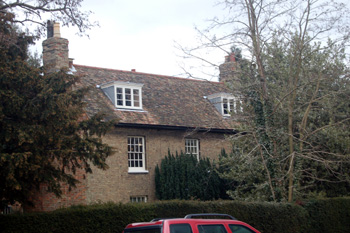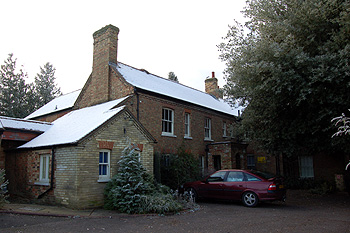Manor Farmhouse - 76 London Road Girtford

76 London Road March 2010
Manor Farmhouse was listed by the former Department of Environment in December 1979 as Grade II, of special interest. The department dated the property to about 1840. It has a yellow brick front with the remainder of the property built in the light red brick prevalent in 19th century buildings in Girtford. It has an old clay tile roof and comprises two storeys and attics in an L-plan. A modern extension at the rear dates from the date 20th century. The manor after which the house was named was, presumably, the Manor of Girtford, held by the Pym family since the mid 18th century.
Plans and specifications survive for new farm buildings in both 1890 [PM1/91] and 1912 [PM1/93] when the farm was owned by the Pym family of Hassells Hall. The 1890 buildings were an open shed and onion loft and a cow house. Head of the Sandy Fire Brigade Lot Hendry tendered for the work. The 1912 buildings were a new barn and a new seed dressing barn. Harry Cope of Saint Neots Road undertook to build them both for £122.
In 1915 Francis Pym conveyed Manor Farm to Ebenezer Marshall for £2,200 [CCE844/7/1]. The farm comprised the house and various closes of land amounting to 19 acres, 7 poles.
The Rating and Valuation Act 1925 specified that every building and piece of land in the country was to be assessed to determine its rateable value. Sandy, like most of the county, was assessed in 1927 and the valuer visiting 76 London Road [DV1/C29/15] found it owned by Frank Davison of Willington and occupied by Mrs. R. E. Marshall, a tenant for life who lived there rent-free. Davidson had only bought the property that year, from the executors of Ebenezer Marshall, for £1,800. The farm now comprised the house and 9 acre, 3 poles of land [CCE844/7/1].
The brick and tiled house stood in 1.397 acres and comprised three reception rooms, a kitchen, a scullery, a pantry and a larder. Four bedrooms, a bathroom and w. c. lay upstairs. Two box rooms lay on the second floor.
A brick and slated shed stood outside along with a brick and tiled range comprising a room, a pail closet, a washhouse, a harness room and two sheds. There was also a brick and tiled office (“good”) measuring 15 feet 6 inches by 11 feet which was empty and an old wooden summerhouse which was overgrown. The valuer commented: “Nice House in rotten situation”.
Adjoining farm buildings were occupied by F. Davison. They stood in just over a third of an acre and comprised: a wood, tile and boarded “old, bad” range comprising a two stall stable, a shed and two further stalls; a weather-boarded and tiled open shed, two old carriage sheds and a small open shed; a wood and tiled single and double stalled stables; a large stable and a corn store; an old wood and thatched building containing a cow stall, two separate cow stalls, a “larger” cow shed and a barn; a wood and tiled four bay open shed; a wood and corrugated iron four bay open shed; a timber and thatched drying loft; a wood and corrugated iron two bay open shed; a brick and tiled storage shed (“good”) measuring 30 feet by 20 feet; a small open shed; a brick, wood and tiled corn and wheat store with four bins and a two bay open shed; a wood and tiled closed shed (“old”) and a brick, wood, tiled and corrugated iron five bay open fronted shed with a drying loft over. The valuer commented: “Very good, all empty at present”.
Frank Davison died at Willington in 1933 and three years later his son Claude Reginald conveyed Manor Farmhouse to Woodis Pascal Rogers of Pavenham for £475 [CCE844/7/1]. He conveyed the house to Sybil Fitzgerald Cluysanaar of Henley-on-Thames [Berkshire] in 1942 for £2,100 [CCE844/9] and she to Gerald Affleck Graves of Leamington Spa [Warwickshire] two years later for £2,800 [CCE844/11]. He sold Manor Farmhouse just a few months later to Henry Francis Capon of Welwyn [Hertfordshire] for £3,400 [CCE844/16].
Capon sold the farmhouse to Arden Arundel Anderson in 1946 for £2,650 [CCE844/19] and he sold it to George Cyril Shelbourn of Renhold a few months later for £3,300 [CCE844/23]. Then, in 1949 Shelbourn sold the farmhouse to Bedfordshire County Council for £2,700 for use as a children’s home [CCE844/1]. The building was later used by a charity supported by the county council, Christian Family Care, as a care centre. Sadly during the recession of the early 21st century funding to the charity was withdrawn and the centre had to close in April 2012. At the time of writing [2013] the property has been sold.
 Manor Farmhouse - side view January 2013
Manor Farmhouse - side view January 2013